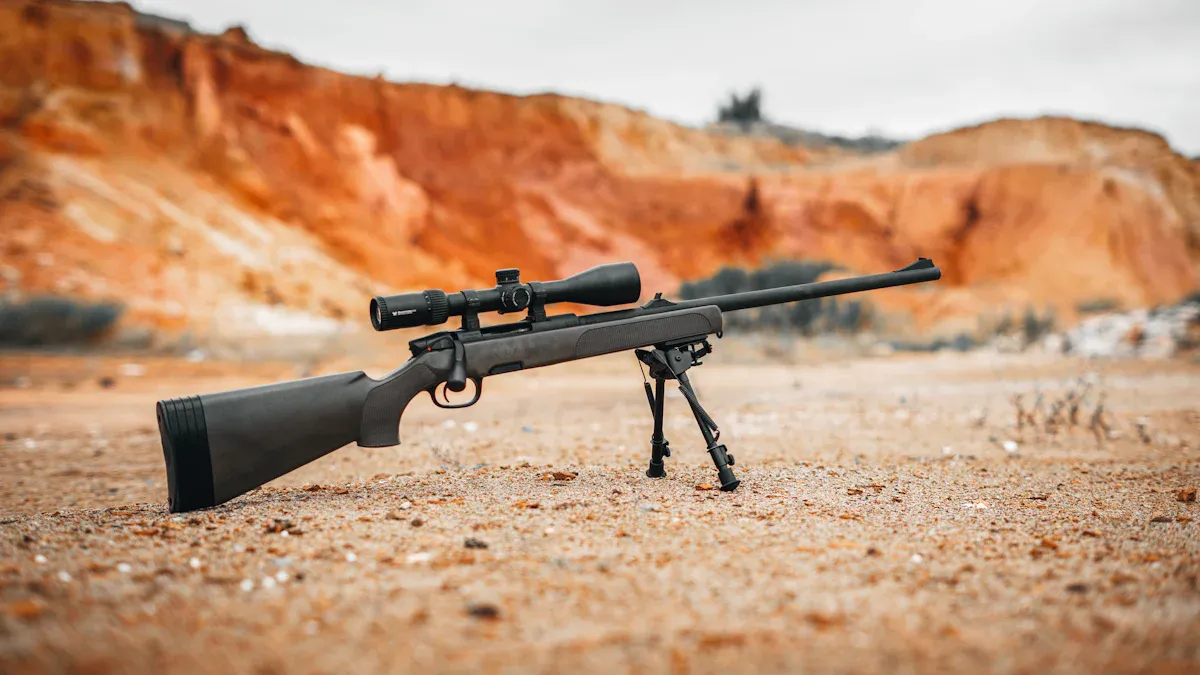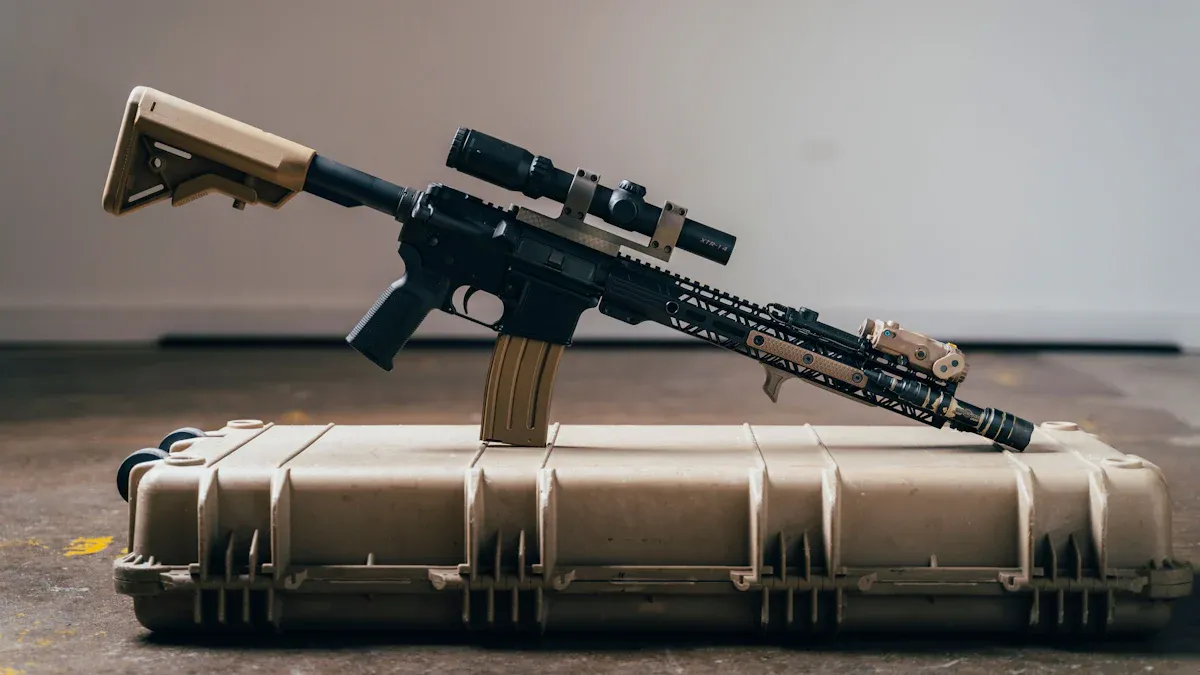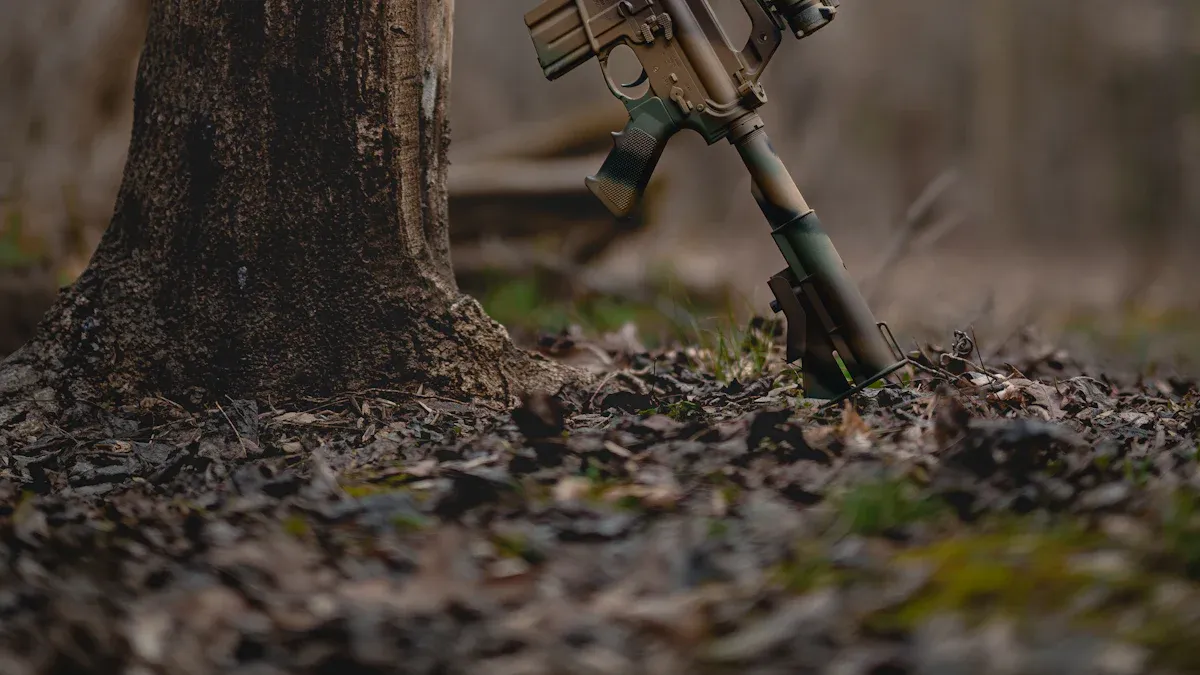
A rifle bipod transforms shooting into an art of precision. It steadies the rifle, allowing shooters to focus on their target without distractions. Hunters trekking through rugged landscapes depend on its durability to maintain accuracy during long-range shots. Whether transitioning from standing to prone or adjusting to uneven ground, the bipod adapts seamlessly. As the surface beneath the bipod shifts, its stability ensures the rifle scope stays aligned, even in challenging terrains. Military snipers and competition shooters trust it to deliver consistent results under pressure. With the right mount and accessories, including a sturdy rail for attachment, it becomes an indispensable tool for any shooter.
Key Takeaways
- Pick a bipod made of strong materials like aluminum or carbon fiber. This ensures it lasts a long time.
- Find one with legs you can adjust to fit your shooting position. This makes it useful in different places.
- Choose bipods that can swivel and pan. These help you follow moving targets easily and shoot better.
Key Features of a Rifle Bipod

Durability
A rifle bipod must endure the toughest conditions. Whether it’s a rocky mountainside or a muddy forest floor, durability ensures the bipod performs without fail. High-quality materials like aircraft-grade aluminum or carbon fiber make a difference. These materials resist wear and tear while keeping the bipod lightweight. Hunters and competitive shooters often praise durable bipods for their ability to handle rough handling and extreme weather. A sturdy bipod not only lasts longer but also provides consistent stability, even after years of use.
Adjustability
Adjustability transforms a rifle bipod into a versatile tool. Shooters can modify leg heights to match their shooting position, whether prone, kneeling, or seated. Many bipods offer adjustable ranges, such as 6 to 9 inches or 9 to 13 inches, catering to different needs. Quick-deploy legs with locking mechanisms prevent unwanted movement, ensuring steady shots. Adjustable cant and pivot features also help shooters track moving targets or level their rifles on uneven ground. This flexibility makes adjustability a must-have feature for any shooter.
Swivel and Pan Capabilities
Swivel and pan capabilities elevate the functionality of a rifle bipod. These features allow the rifle to move horizontally and vertically without repositioning the bipod. For hunters, this is a game-changer. It enables them to follow targets smoothly and take accurate shots, even at long distances. Competitive shooters benefit too, as they can make quick adjustments during matches. A bipod with these capabilities ensures precision and adaptability in dynamic shooting scenarios.
Interchangeable Feet for Versatility
Interchangeable feet add a layer of versatility to a rifle bipod. Rubber feet provide grip on smooth surfaces, while spiked feet dig into soft ground for added stability. Some bipods even offer claw-style feet for rocky terrain. This feature allows shooters to adapt to various environments without compromising stability. Whether on a concrete range or a muddy field, interchangeable feet ensure the bipod stays firmly in place, enhancing accuracy and confidence.
Types of Rifle Bipods
Short Bipods (6-9 inches)
Short bipods are the go-to choice for prone shooting. Their compact design makes them perfect for bench shooting or lying flat on the ground. With legs measuring between 6 and 9 inches, they provide a stable platform for precision shots. Many models feature adjustable legs, allowing shooters to fine-tune their height for different surfaces. For example, some bipods include five preconfigured height settings, making them versatile in the field.
Rubber feet on these bipods ensure excellent traction on smooth surfaces, while their lightweight construction makes them easy to carry. Hunters and target shooters often favor short bipods for their ability to enhance stability without adding bulk. Whether shooting off a bench or navigating uneven terrain, these bipods deliver reliable performance.
Medium Bipods (9-13 inches)
Medium bipods strike a balance between portability and versatility. Their adjustable legs, ranging from 9 to 13 inches, make them suitable for both prone and seated shooting positions. This flexibility allows shooters to adapt to various environments, from grassy fields to rocky hillsides.
Many medium bipods feature quick-deployment systems, enabling shooters to set up in seconds. Some models even include spring-loaded legs for faster adjustments. These bipods are ideal for hunters who need to switch positions quickly or competitive shooters who require stability during matches. With their robust design and adjustable features, medium bipods cater to a wide range of shooting scenarios.
Tall Bipods (12-27 inches)
Tall bipods are the champions of versatility. Their extended legs, reaching up to 27 inches, allow shooters to adopt multiple positions, including kneeling and sitting. This makes them invaluable in dynamic environments where prone shooting isn’t an option. For instance, a precision rifle competitor using a tall bipod achieved tight groupings at over 800 yards, showcasing its effectiveness in long-range shooting.
These bipods excel in rugged conditions. Their sturdy construction provides stability, enabling shooters to focus on windage and elevation without worrying about rifle control. Whether hunting in dense brush or competing in a match, tall bipods offer the adaptability needed for success.
Mounting Systems for Rifle Bipods

Picatinny Rail Mounts
Picatinny rail mounts are a favorite among shooters for their quick attachment and removal capabilities. These mounts excel in dynamic shooting scenarios, where adaptability is key. Many bipods designed for Picatinny rails allow for canting or pivoting, offering flexibility during target tracking. Shooters appreciate the ease of switching between rifles, though adjustments may be necessary to ensure a secure fit.
- The Javelin Bipod, for instance, features a magnetic attachment system that works seamlessly with Picatinny rails.
- Testing has shown that secure mounting is crucial for accurate measurements, as high accelerations can lead to errors.
- Picatinny rail mounts also support various bipod designs, including those with adjustable leg lengths and panning features, enhancing their usability across different shooting contexts.
M-LOK and Keymod Mounts
M-LOK and Keymod mounts have gained popularity for their lightweight design and versatility. These systems provide a sleek, low-profile attachment method, making them ideal for modern rifles. A study by USSOCOM highlighted M-LOK’s superior performance, with more aftermarket products available compared to Keymod.
| Mounting System | Advantages | Disadvantages |
|---|---|---|
| M-LOK | More aftermarket products, superior stability | Requires careful installation |
| KeyMod | Stability and full engagement | Fewer aftermarket options |
| AI Keyslot | Superior stability | Limited compatibility with aftermarket parts |
Shooters often choose M-LOK for its broad compatibility, while Keymod appeals to those seeking a simpler installation process. Both systems ensure a secure connection, enhancing the rifle’s overall performance.
Sling Swivel Stud Mounts
Sling swivel stud mounts offer a classic and reliable option for attaching a rifle bipod. These mounts are particularly popular among hunters and traditional rifle enthusiasts. The MOE bipod, for example, features a rapid-attach sling stud system, allowing for quick and easy setup.
- Stainless steel clasps ensure perfect alignment during mounting.
- A large ergonomic thumbwheel provides a strong grip for tightening.
- Some models, like the CVLIFE bipod, include an extra sling loop for attaching a rifle sling rope.
Data from the Precision Rifle Series (PRS) shows that many top competitors rely on sling swivel stud mounts for their durability and ease of use. These mounts deliver consistent performance, making them a dependable choice for various shooting scenarios.
Matching a Rifle Bipod to Your Needs
Identify Your Shooting Style
Every shooter has a unique style, and the right bipod complements it perfectly. Some prefer prone shooting for its stability, while others favor sitting or standing positions for dynamic environments. Bipods allow shooters to adapt to these styles effortlessly. Quick deployment becomes a lifesaver for hunters and tactical shooters who operate under time pressure. However, portability matters too. A lightweight bipod suits those who move frequently, while heavier models provide unmatched stability for precision shooters. Over-reliance on bipods, though, can lead to neglecting freehand shooting skills, which remain essential for versatility.
Consider Your Shooting Environment
The terrain plays a significant role in bipod performance. Hard, level surfaces offer the best stability, making them ideal for long-range shooting. On soft ground, however, bipods may sink, altering the rifle’s angle and affecting accuracy. Uneven terrain adds another layer of complexity, often requiring shooters to adjust their setup for consistent results. Sandbags or alternative supports sometimes outperform bipods in such conditions. Proper setup and technique, regardless of the environment, ensure the best outcomes. Shooters who frequently encounter varied terrains should prioritize bipods with interchangeable feet for maximum adaptability.
Match the Bipod to Your Rifle Type
Not all bipods suit every rifle. Lightweight hunting bipods excel in outdoor scenarios, offering quick setups for hunters. Target shooting bipods, on the other hand, are heavier and provide exceptional stability for competitive events. Tactical bipods, built for durability, thrive in adverse conditions, while precision bipods cater to marksmen with their high adjustability. Tripods, with their three-legged design, shine on uneven ground, supporting standing or sitting positions. The table below highlights ideal bipod types for specific use cases:
| Type of Bipod | Description | Ideal Use Case |
|---|---|---|
| Hunting Bipods | Lightweight and compact, designed for outdoor use. | Quick setups for hunters |
| Target Shooting Bipods | Larger and heavier, offering excellent stability for competitive shooting. | Range and competitive events |
| Tactical Bipods | Durable and stable, designed for military and law enforcement use. | Adverse conditions and heavy use |
| Precision Bipods | Highly adjustable, made for competitive shooters and precision marksmen. | Precision shooting |
| Tripods | Provide greater stability with three legs, ideal for uneven ground. | Standing or sitting positions |
Test for Comfort and Stability
Comfort and stability are non-negotiable when selecting a rifle bipod. A stable platform minimizes movement, allowing shooters to focus on their aim and trigger control. This becomes especially critical in long-range shooting, where even slight deviations can lead to missed targets. Bipods also reduce fatigue, supporting shooters in prone or semi-prone positions. Military snipers and competition shooters rely on them for precision under pressure. Hunters benefit too, as bipods enhance accuracy during extended field sessions. Testing a bipod before purchase ensures it meets these criteria, boosting confidence and performance in every shot.
Selecting the right rifle bipod transforms shooting experiences. A durable and adjustable bipod enhances stability and accuracy, making it a must-have for hunters, competitors, and tactical shooters.
Key Benefits of Rifle Bipods:
- Stability: Reduces rifle movement, ensuring precise shots.
- Improved Accuracy: Essential for long-range and precision shooting.
| Benefit | Description |
|---|---|
| Stability | A bipod helps to stabilize the rifle, reducing uncertainty in shot placement. |
| Improved Accuracy | Using a bipod enhances shooting accuracy, especially in precision shooting scenarios. |
A hunter once shared how a lightweight, adjustable bipod improved their aim during a challenging hunt. This story highlights the importance of matching bipods to individual needs. Whether prioritizing rugged durability or quick deployment, the right bipod ensures confidence in every shot.
FAQ
What is the best material for a durable rifle bipod?
Aircraft-grade aluminum or carbon fiber works best. These materials balance strength and weight, ensuring the bipod survives rugged conditions without adding unnecessary bulk.
Post time: Mar-25-2025
